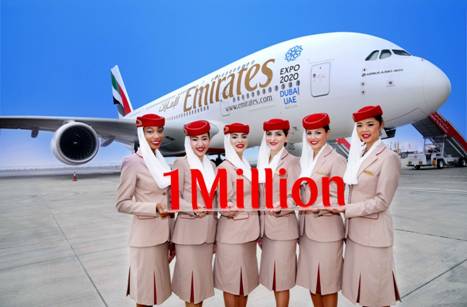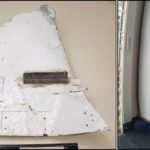
The Emirates group has announced its 28th consecutive year of profit and steady business expansion, ending the year with record profits, and in a strong position despite the global and operational challenges during this period.
During the 2015-16 financial year, both Emirates and dnata achieved new capacity and profit milestones, as the Group continued to expand its global footprint, and strengthen its business through strategic investments.
Released last week, in its 2015-16 Annual Report, the Emirates Group posted an AED 8.2 billion (US$ 2.2 billion) profit for the financial year ending 31 March 2016, up 50% from last year. The Group’s revenue reached AED 93 billion (US$ 25.3 billion), a decrease of 3% over last year’s results, and the Group’s cash balance increased strongly to AED 23.5 billion (US$ 6.4 billion).
His Highness (H.H.) Sheikh Ahmed bin Saeed Al Maktoum, Chairman and Chief Executive, Emirates Airline and Group, said: “Emirates and dnata delivered record profits, solid business results, and continued to grow throughout 2015-16. Against an unfavourable currency situation which eroded our revenues and profits, an uncertain global economic environment dogged by weak consumer and investor sentiment, as well as ongoing socio-political instability in many regions around the world, the Group’s performance is testament to the success of our business model and strategies.
“Our ongoing investments to develop our people and to our enhance business performance, enable us to react with agility to the new challenges and opportunities that every year brings. In 2015-16, the Group collectively invested over AED 17.3 billion (US$ 4.7 billion) in new aircraft and equipment, the acquisition of companies, modern facilities, the latest technologies, and staff initiatives. These will build on our strong foundations, extend our competitive edge, and accelerate our progress towards our long-term goals.”
The Group’s employee’s base across its more than 80 subsidiaries and companies increased by 13% to over 95,000-strong representing over 160 different nationalities.
“Looking at the year ahead, we expect that the low oil prices will continue to be a double-edged sword – a boon for our operating costs, but a bane for global business and consumer confidence. The strong US dollar against major currencies will remain a challenge, as will the looming threat of protectionism in some countries. However, we enter the new financial year with confidence, backed by a robust balance sheet, solid track record, diverse global portfolio, and international talent pool. We will continue to evolve and grow our business profitably, and work even harder to meet and exceed our customers’ expectations,” said Sheikh Ahmed.
In line with the overall profit, the Group declared a dividend of AED 2.5 billion (US$ 681 million) to the Investment Corporation of Dubai.
Emirates performance Emirates’ total passenger and cargo capacity crossed the 56 billion mark, to 56.4 billion ATKMs at the end of 2015-16, cementing its position as the world’s largest international airline. The airline increased capacity during the year by 5.5 billion Available Tonne Kilometres (ATKMs), or 11% over 2014-15.
Emirates received 29 new aircraft, its highest number during a financial year, including 16 A380s, 12 Boeing 777-300ERs and one Boeing 777F, bringing its total fleet count to 251 at the end of March. At the same time nine aircraft were phased out, taking the average fleet age down to 74 months or approximately half the industry average of 140 months. The airline remains the world’s largest operator of the Boeing 777 and A380 – both aircraft being amongst the most modern and efficient wide-bodied jets in the sky today.
With the delivery of new aircraft, Emirates launched eight new passenger destinations: Bali, Bologna, Cebu, Clark, Istanbul (Sabiha Gökçen), Mashhad, Multan, Orlando; and two new additional freighter destinations: Columbus and Ciudad del Este. It also added services and capacity to 34 cities on its existing route network across Africa, Asia, Europe, the Middle East, and North America, offering customers even greater choice and connectivity.
With significant currency devaluations against the US dollar and fare adjustments following the reduction in fuel prices, Emirates revenue dropped 4% to AED 85 billion (US$ 23.2 billion).
The relentless rise of the US dollar against currencies in most of Emirates’ key markets had an AED 6.0 billion (US$ 1.6 billion) impact on airline revenue, and an AED 4.2 billion (US$ 1.1 billion) impact to the airline’s bottom line.
However, total operating costs decreased by 8% over the 2014-15 financial year. The average price of jet fuel fell during the financial year, supporting Emirates’ bottom line improvement. The airline’s fuel bill decreased by 31% over last year to AED 19.7 billion (US$ 5.4 billion). Fuel is now 26% of operating costs, compared to 35% in 2014-15, but it remained the biggest cost component for the airline.
The airline successfully managed increased competitive pressure across all markets to record a profit of AED 7.1 billion (US$ 1.9 billion), an increase of 56% over last year’s results, and a healthy profit margin of 8.4%, the strongest margin since 2010-11.
Varying a record 51.9 million passengers (up 8%), Emirates crossed the 50 million passenger milestone, and achieved a Passenger Seat Factor of 76.5%. The decline in passenger seat factor compared to last year’s 79.6%, is relative to the strong 13% increase in seat capacity by Available Seat Kilometres (ASKMs), and also in part due to lingering economic uncertainty and strong competition in many markets.
Overall passenger traffic growth continues to demonstrate the consumer desire to fly on Emirates’ state-of-the-art aircraft, and via efficient routings through its Dubai hub. Premium and overall seat factor for Emirates’ flagship A380 aircraft outperformed the network, underscoring the popularity of Emirates’ premium and A380 product amongst passengers. At 31 March 2016, Emirates had 75 A380 aircraft in its fleet, serving one out of every four destinations on its passenger network.
Emirates closed the financial year with a healthy and new record of AED 14.1 billion (US$ 3.8 billion) cash flow from operating activities.






